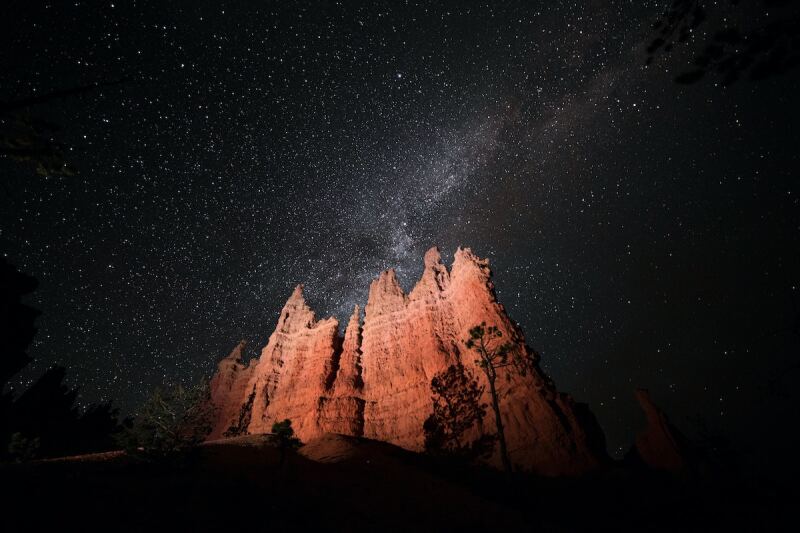From the Editor
Ready, set, breathe
All through 2020, it has felt like the world has been holding its breath—constricted by anxiety and fear, afraid to talk to others, even breathe on others. But what a feeling, to finally exhale. Want to know what it looks like to see an entire city exhale? Google videos of New York City on November 7. Or Philadelphia. Or Washington, D.C. It’s a jubilant, exultant scene.
Where else have you snuck away this year to find that release from your worries? If you feel like that experience has been elusive, consider this inspiration for ways and places to exhale safely around the world. It could be a quiet corner of the woods in British Columbia, where you can safely drop your guard (and mask), or maybe it’s beneath the ocean’s surface in the depths of Belize’s Blue Hole, where a scuba mask and gear actually help you breathe.
Remember, too, that exhaling doesn’t happen without that first, proper breath in–something you might have forgotten how to do. In this package, we’ll discuss how to breathe intentionally with Richie Bostock, aka “The Breath Guy,” an expert and self-proclaimed evangelist on breathwork; we’ll also talk about reinvigorating your senses when you travel. Taking in the scent from the local bakery, reclining on the beach with your pulse slowing, even scaling a mountain and gasping for oxygen—your body is just waiting to exhale in 2021. Let us show you how. —Laura Dannen Redman, digital content director
Breathwork, Explained

Animation by Christopher Udemezue/Courtesy of the Belize Tourism Board
Are you telling me I don’t know how to breathe?
Yes, we all breathe. Thankfully, our body does it automatically, because left to our own devices, we might deprioritize it to disastrous results. It seems we lack the awareness of how to breathe constructively—though it’s all within our control. “If you’ve ever watched a baby breathe, they do it naturally, from the diaphragm, belly rising with each inhale. But over time, stress and changes in our bodies cause us to engage in more shallow, chest breathing,” says Madefor, a 10-month wellness program designed to help you focus on rewiring your brain to live more effectively—be it how you hydrate, eat, sleep, or breathe. “In general, a long inhale and short exhale achieves an energizing effect; while a short inhale and long exhale have a calming effect.”
That’s just for starters. Australian-born, U.K.-based Richie Bostock has made a career out of coaching athletes, corporations (including Google and Lululemon), and people like us in the art and science of breathing; its physical, emotional, and mental significance; and breathing’s cultural nuances around the world. In ancient Greek, the word for soul, psyche or pneuma, also means breath. Tibetans, Sufis, Taoists, and spiritual masters have all developed their own sacred breathing techniques, says Bostock.
On January 28 at 12 p.m. EST, Bostock—now known as “The Breath Guy”—will join us in conversation on “Learning to Exhale,” empowered by the Belize Tourism Board, including a live, interactive breathing exercise to get us all on the right path for the year. Registration details to come, as well as a trip giveaway!
His new book, Exhale (Penguin Life, $16, October 2020), serves up 40 breathwork exercises to “help you find your calm, supercharge your health, and perform at your best.” His journey from businessman to breathing expert, though, begins shortly after his father was diagnosed with multiple sclerosis (MS). Seeking ways to help his Dad cope with the disease—which has no known cure—led him to a fateful dip in zero-degree water in Poland where Bostock found something akin to breathwork enlightenment. An awareness of breathing, breathwork’s power lies in using “it to improve your physical and mental health and performance and emotional well-being,” Bostock writes. What he learned in Eastern Europe didn’t just set Bostock’s life on a new path—it also profoundly changed the course of his dad’s illness.
Read the full story in an exclusive excerpt from Exhale.
Ecotherapy

Photo by NAAN/Shutterstock
Forest bathing. Flaneuring. Social distancing with gorillas.
“We often associate ‘getting outdoors’ with scaling mountains, standing on dramatic summits, trekking into the jungle, and doing other adrenaline-driven activities far from the reach of cell service,” writes AFAR contributor Josh Laskin in his dissection of “ecotherapy.” “Spending time in nature doesn’t have to be intense. It can mean walking on an empty beach as the sun sets, resting by a stream, sitting on the lawn behind your hotel, or even just being more aware of outdoor surroundings.”
Broadly speaking, “ecotherapy” refers to interacting with nature to improve healing and growth, according to the National Institutes of Health. In a 2015 study published in the Proceedings of the National Academy of Sciences of the United States of America, participants were asked to walk for 90 minutes in either a natural or urban setting. “Researchers determined that, compared to those in urban environments, people who walked in the natural setting had lower levels of repetitive negative self-thought—or rumination—and a decreased level of activity in the prefrontal cortex (a part of the brain linked to mental illness, anxiety, and stress),” wrote Laskin.
The setting is ideal for working on your breathwork, with several types of fresh-air activities prompting a reinvigoration of senses.
Forest bathing: The Japanese Ministry of Agriculture, Forestry and Fisheries coined the term shinrin-yoku—which roughly translates to “forest bathing,” or practicing mindfulness in a natural setting—back in 1982. Starting in 2006, the Forest Therapy Society began officially registering rural areas in Japan that have been tested to have a positive physiological impact on people. Read more in “Why You Should Go Forest Bathing in Japan” by Katie Lockhart.
Flaneuring: “A flaneur describes someone who practices the act of wandering with intention,” writes Erika Owen in “How to Master the Art of Flaneuring Around Your Neighborhood.” “There’s no route in mind, but the flaneur is constantly ready to soak in their surroundings. Originally a French term from the 19th century, it was used to describe men who would go on long walks to gather observations for party talk, essays, poetry, and other intellectual ramblings. (Women who wandered were unfortunately called other names.) . . . The idea of wandering with this kind of intention is simple—on paper: Step outside with an open mind and wide eyes.”
Animal walks: You can’t help but hold your breath at the first glance of a gorilla in the wild. (Your heart practically leaves your chest.) But learning to measure your breathing among the silverback gorillas of Rwanda’s Volcanoes National Park, or near a giant Galápagos tortoise on Santa Cruz Island of the Galápagos, awakens other senses. You see details in heightened relief, and the rush of adrenaline is followed by an unexpected peace as you witness other walks of life. “That’s another special thing about a land-based Galápagos trip: While others are clambering onto their ships for dinner, we move at a leisurely pace, savoring the scenery,” says Ashlea Halpern in “Galápagos by Land: You’ve Never Seen the Islands This Way.” A little closer to home? Visit the remote coastal split where wild horses roam.
READ MORE
Exhale in Belize with These Outdoor Adventures
Go Remote

Photo by sixfournorth/Shutterstock
Would you spend your vacation in silence?
“By the time you finish reading the end of this sentence, you will most likely have been interrupted by a sound—some scrape, some snarl, a click, clock, clack. A plane may buzz overhead. A microwave may beep, or your phone may ring. That damn doorbell. That damn dishwasher. How do I know this? Because Gordon Hempton says so,” writes Katherine LaGrave in The God of Silence Speaks Up. “How does Gordon Hempton know this? Because for the past 37 years, the acoustic ecologist has been thinking about noise and listening and doing what some may think unthinkable, unimportant in a world with climate change and animal extinction and a planet that keeps getting hotter: trying to save quiet.”
Of late, Hempton has focused on Quiet Parks International (QPI), a Los Angeles–based nonprofit he cofounded that’s “committed to the preservation of quiet for the benefit of all life.” Though you can count the number of official Quiet Parks on one hand—the first certified was a 200,000-acre spread of land in Ecuador owned by the indigenous Cofán tribe, the second Yangmingshan National Park, some 25 minutes from downtown Taipei by car—Hempton hopes that QPI follows a similar trajectory to that of the International Dark-Sky Association, parts of the world that are free of light pollution.
Can you imagine focusing your travels on finding absolute quiet or an unadulterated night sky? In the last few years, silent meditation retreats have grown in popularity, and a sort-of celestial tourism has developed around star-gazing destinations across the globe. Here, AFAR contributors talk about their peaceful happy places, designed to help you catch your breath.
- A Remote Alaskan Lodge Takes You Deep Into the Wild
- Living the Scandinavian Dream in the Pacific Northwest
- In Big Sur, Learning the Value of Being Alone
- On Moosehead Lake, Finding Calm in the Chaos
- A Remote Alaskan Lodge Takes You Deep Into the Wild
- This Hidden Corner of British Columbia Is A Site of Small Pleasures











